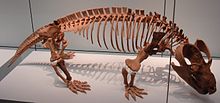Cynodontia
| Cynodontia | ||||||||||||
|---|---|---|---|---|---|---|---|---|---|---|---|---|

Skull of the genus Cynognathus |
||||||||||||
| Temporal occurrence | ||||||||||||
| Middle Perm to this day | ||||||||||||
| 270 to 0 million years | ||||||||||||
| Locations | ||||||||||||
|
||||||||||||
| Systematics | ||||||||||||
|
||||||||||||
| Scientific name | ||||||||||||
| Cynodontia | ||||||||||||
| Owen , 1859 |
The cynodontia (literally "dog teeth") are the group of Therapsida (formerly called "mammal-like reptiles") with the greatest biodiversity . Today they are represented by mammals , all other subgroups died out in the Mesozoic .
The first cynodontia appeared about 270 million years ago during the Permian . Fossils from this period have been found in South Africa, Zambia , Russia and Western Europe. The animals survived the mass extinction at the end of the Permian and experienced rapid adaptive radiation in the Triassic , a development that culminated in the emergence of mammals. Those cynodontia that were not mammals probably survived as far as the Lower Cretaceous , or at least as far as the Middle Jurassic .
features
The Cynodontia share a number of characteristics with the Therocephalia , with which they together form the taxon Eutheriodontia . Their monophyly is well founded by a total of 27 synapomorphies , most of them affecting the skull. Their skulls are similar to those of mammals, the temporal region is wide, the zygomatic arch is wide, the muzzle is usually low. From Procynosuchus apart and his relatives, there is a secondary palate, the respiratory and Nahrungsweg separates all Cynodont. There are no palatal windows. The wing bone no longer reaches the square bone at the back . The square zygomatic bone, which is missing in mammals, and the square bone, which has become the anvil , one of the ossicles , in mammals are greatly reduced. On the large, plate-shaped back of the head, the two head joints of mammals gradually emerge.
In the lower jaw, the dental is by far the largest bone. The bones behind it continue to regress. In the lower jaw, the canines are followed by 7 to 13 molars, which are wide and have numerous cusps. The molars are partially divided into premolars and molars .
Only a few complete skeletons were found; the tail was probably mostly short. There are always four cross vertebrae . The limbs, shoulder and pelvic girdles are similar to mammals , the number of toe joints, similar to that of reptiles, is still high ( phalangeal formula 2,3,4,4,3).
Systematics
| Cynodontia |
|
|||||||||||||||||||||||||||||||||||||||||||||
|
|
literature
- Thomas S. Kemp: The Origin & Evolution of Mammals. Oxford University Press, Oxford 2005. ISBN 0-19-850761-5 .
- Oskar Kuhn: The mammal-like reptiles . A. Ziemsen Verlag, 2003, ISBN 3-89432-797-9 .
Web links
- Palæos Cynodontia: Overview


